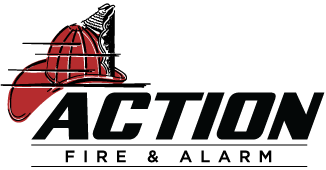Our experience proves that proper installation and maintenance can spell the difference between a close call and an abject disaster. We provide full sprinkler system design, installation, service repair, and all NFPA-required sprinkler inspections. Our conscientious, knowledgeable professionals install and maintain dry pipe systems, wet pipe systems, fire pumps, deluge systems, and pre-action systems. Don’t regret making a decision too late; let Action Fire & Alarm install a system today and protect your assets.
Sprinkler System Installation
With over 75 years of experience, our sales and technical staff have the experience and knowledge to ascertain your commercial and residential fire protection needs and tailor a proposal based on specific job conditions, budget constraints and schedule concerns.
Our experience and abilities allow us to provide every aspect of fire protection needs for the following types of projects:
- Commercial Tennent
- Commercial Office Building
- Commercial Warehouse
- Hospitals
- Schools
- Retail Stores
- Restaurants
- Hotels
- Residential Single-Family Homes
- Residential Multi-Family Units
- Apartments
Once under contract, the fire protection concept is transferred into permit drawings and then finalized into shop drawings coordinated with the mechanical, electrical and plumbing trades. Exclusive use of CAD and BIM coordination make our layouts fully compatible with our customers’ needs.
Installation by our professional crew is streamlined by equipping them with the most updated and properly maintained tools and equipment. Our sprinkler fitters deliver greater value through safe and efficient field operations.
Inspections
To ensure their reliability, fire sprinkler systems must be inspected, tested and maintained in accordance with the requirements of the National Fire Protection Association (NFPA), your local Authority Having Jurisdiction (AHJ) and your insurance company. Action Fire and Alarm will perform a program of periodic testing, inspection and maintenance that is right for you and conforms to NFPA code requirements as well as the requirements of your local AHJ.
Each year, we perform thousands of inspections on new and existing systems to determine compliance with fire codes, insurance requirements and client needs. These inspections assure optimum system operation, response times, and proper operation of the fire sprinkler systems.
As part of our inspections, Action Fire and Alarm will inspect and test the operation and conditions related to fire sprinkler systems in accordance with the National Fire Protection Association (NFPA) 25 standards. We compile a complete report of inspection, explain any deficiencies and recommend corrective action to be taken according to recognized care and maintenance standards. Inspections include:
- Main drain test during which the static, residual and restored pressures are recorded
- Inspector’s test valve activation during which the alarm bell is tested and records of the alarm monitoring activities are taken
- Operating and testing all control valves and ensure that they are secured from tampering
- Visual inspection of fire sprinkler heads, hangers and seismic bracings
- Verify proper sprinkler coverage throughout the premises
- Inspect for damages or obstructions that could potentially hinder the proper operation of the sprinkler systems
- Ensure the presence of signage as required by the jurisdiction
- Provide reports of each system on the state’s form
- Provide compliance report for record-keeping
Repair Service
Our experienced technicians are ready to help your business return to normal operation by quickly responding to provide you Fire Sprinkler System Repair Service. Leaky sprinkler heads, broken pipes or malfunctioning sprinkler systems are some of the problems that can lead to major losses if corrective actions are not taken on a timely manner. Some common repairs include:
- Leaky Pipes or sprinkler heads
- Loose or broken pipes
- Jammed or malfunctioning control valves
- Below normal pressure
- Corroded sprinkler heads or pipes
- Obsolete parts or equipment
- Damaged or inoperable backflow preventers
- Loose or broken seismic braces or hangers
- Problems with flow or tamper switches



